What is Sales? Definition and How to Become a Salesperson
Casey O'Connor
The definition of sales is both simple and complex, depending on who you ask (and how much time you have).
The word sales acts like an umbrella, encompassing all of the many activities that are involved in persuading a customer to purchase a product or service in exchange for compensation. In this sense, it’s the term for an exchange of goods for money.
The definition of sales can also include the people responsible for it, and the department as a whole.
At its heart, though, the true definition of sales is this: meeting a customer’s needs and providing a solution to their problem.
In this article, we’ll go over absolutely everything you need to know about sales, including what makes it different from marketing, the differences between B2B and B2C sales, how to become a successful salesperson, and more.
Here’s what we’ll cover:
- The Definition of Sales
- How is Sales Different from Marketing?
- Defining Inside Sales vs. Outside Sales
- B2B Sales vs. B2C Sales
- How Do You Become a Salesperson?
- How Do You Build a Sales Team?
- Techniques for Becoming a Great Salesperson
- How to Meet Your Sales Goals
The Definition of Sales
The definition of sales can be hard to pin down, as the term can refer to a number of things.
The word might indicate a field of work: “I work in sales at Coca-Cola.”
It can also refer to a department in an organization: “Pass those leads to sales so we can get the pipeline moving.”
It may also represent the various tasks and activities that salespeople undertake to convince new leads to buy their products. In other words, it stands for the actual act of selling a product: “We need to get sales running more efficiently to hit quota.”
All of these things are synonyms of one another, and certainly well-represented by the word “sales.”
The true definition of sales, though — that is, the stuff that’s at the heart of this profession — is something much deeper than pipelines, sales quotas, and the sale of goods.
When it comes down to it, successful sales is all about building trusting relationships with potential customers and solving problems for them.
People don’t buy products; they buy solutions to problems.
It’s also important to note here that sales is a process — a cycle, really — not a finite, one-time activity.
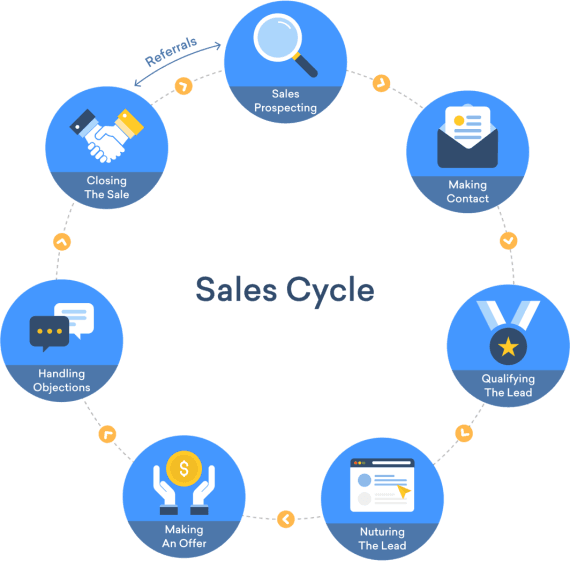
In sum, a sales transaction — whether it occurs in-person, via an e-commerce platform, or any combination in between — occurs when a sales representative provides new customers with a product that meets their needs, in exchange for a certain amount of money.
How is Sales Different from Marketing?
Many people conflate sales and marketing — in today’s day and age, that’s not an unfair assumption. Sales and marketing departments do collaborate closely in the selling process, and the best sales teams enjoy seamless cooperation from their marketing counterparts.
That being said, sales and marketing are decidedly different departments, each with their own goals, activities, and workflow.
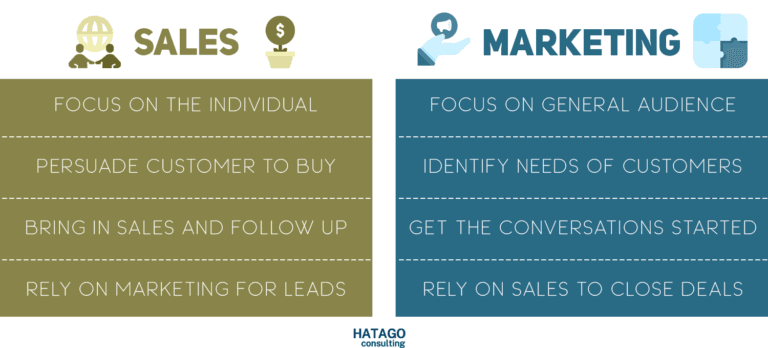
The marketing department’s primary goal is to develop messaging around the product offering, and communicate the value it provides to the customers.
The sales department is then responsible for using sales strategies to execute on the messaging and complete the transaction.
Ultimately, sales and marketing exist in a symbiotic relationship with one another along a continuum in the sales process.
Marketing feeds leads to sales, who are then responsible for closing deals. In turn, marketing is responsible for taking feedback from sales about customer behavior and using it to refine their marketing campaigns. The two departments are co-equal stakeholders in the process.
Defining Inside Sales vs. Outside Sales
In non-pandemic times, when most of the world isn’t working from home, there are two types of salespeople: inside sales and outside sales.
Inside Sales
Inside sales reps sell their product or service remotely, usually from inside the walls of their company’s headquarters.
In other words, they stay in one physical location and connect with buyers over the phone, via email, or sometimes at sales meetings in their office.
Inside sales reps usually rely more heavily on automation to complete their sales process, and their work hours are typically more structured than those of outside reps.
Even before the shift to remote work in 2020, inside sales were on the rise.
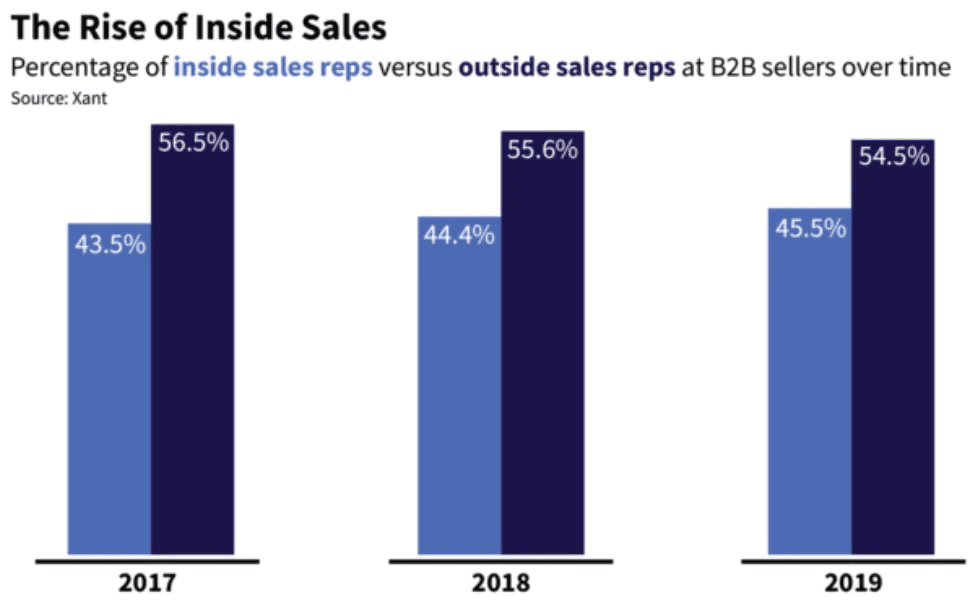
Now, many sales reps have no choice but to perform an inside sales role. One benefit of this shift has been a huge advance in innovative and powerful sales technology.
Outside Sales
Outside sales reps meet with prospects face-to-face. They usually travel a lot, both to meet individual prospects and network at events like conferences and trade shows.
Even with the rise in inside sales work, outside sales reps still represent the majority of sales professionals.
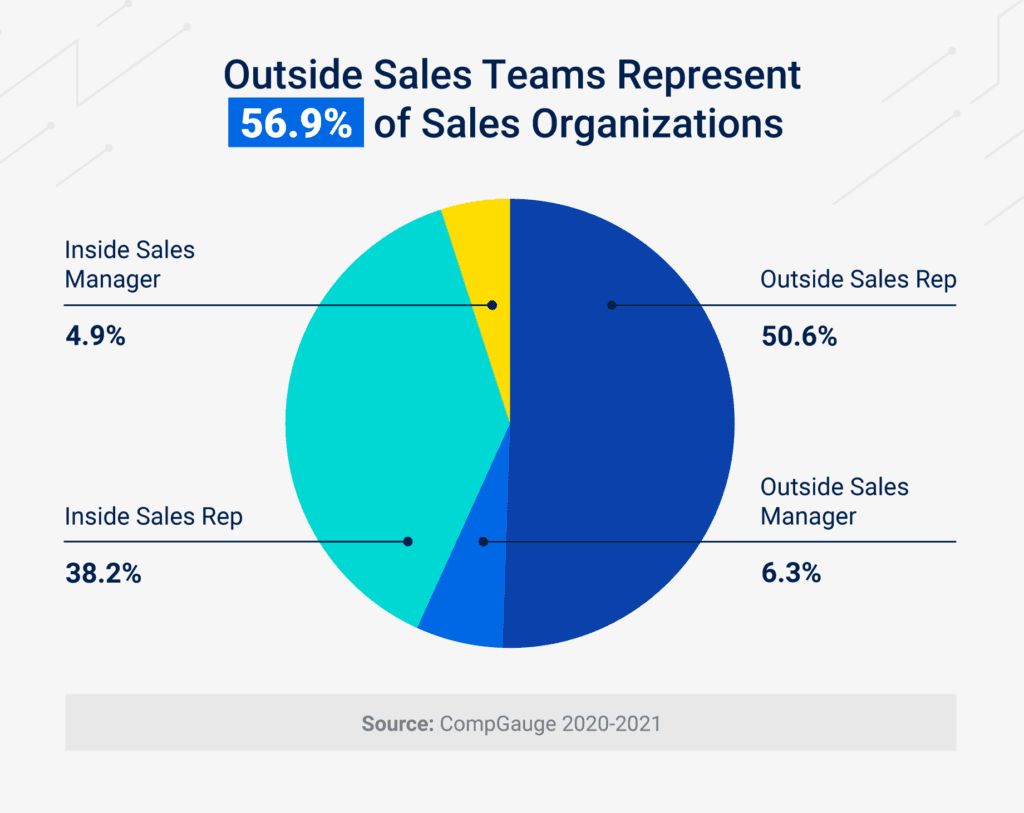
The outside sales role — sometimes called field sales — is typically less regimented, with hours more fluid and variable depending on the rep’s travel schedule.
B2B Sales vs. B2C Sales
Sales can also be defined by the audience to whom they sell. Some companies sell products or services to other businesses; these are called B2B sales organizations. Others, called B2C companies, sell to individual customers.
B2B
B2B — which stands for business to business — businesses are those that sell their products to other businesses.
Usually, the B2B sales process is longer, involves more decision-makers, and deals with higher-priced products.
B2B businesses can range in size, and sell to both SMBs and enterprise companies.
B2C
B2C companies sell “business to customer,” which is a bit of a misnomer — all businesses have customers, not just B2C ones. The defining factor of a B2C company is that it sells directly to individuals, rather than to other businesses.
B2C products are usually cheaper and require a less-involved sales process to complete a deal.
There are different skill sets, advantages, and disadvantages involved in selling B2B or B2C.
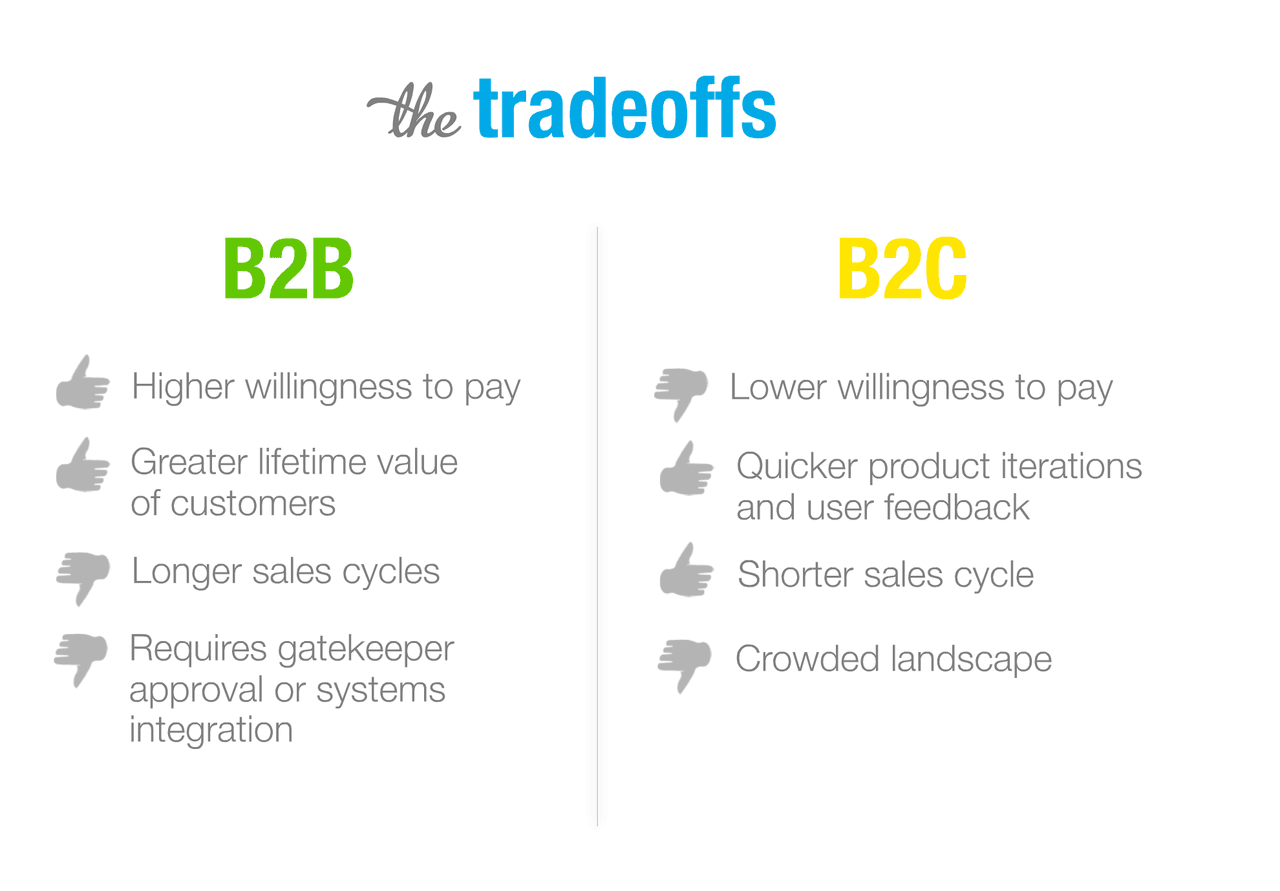 Both types of selling require salespeople to be well-versed in their target audience, the industry into which they’re selling, and their own product details.
Both types of selling require salespeople to be well-versed in their target audience, the industry into which they’re selling, and their own product details.
Tip: 100 common sales terms explained.
How Do You Become a Salesperson?
One of the things that makes a position in sales so attractive to many is that it doesn’t always require a ton of experience to get started in the field.
Although the specifics will vary from company to company, not all sales positions require a college degree. An associate’s or bachelor’s degree in marketing, business, psychology, or consumer behavior may be helpful in onboarding or climbing the ranks more quickly, but are not necessarily required for hiring.
Regardless of your level of formal education, almost all sales positions will require on-the-job training. This may include product training or personal or professional development workshops. The sales training you receive will be unique to the company at which you’re hired.
There are a small handful of trainings that are more universally recognized and may give you a slight advantage in a crowded job market. You could, for example, earn the title of Certified Professional Sales Person (CPSP) through the National Association of Sales Professionals. There’s also a similar certification for inside sales: Certified Inside Sales Professional, offered by the American Association of Inside Sales Professionals.
Even more important than training and certifications are the personal and professional characteristics that salespeople bring with them to their jobs.
The best salespeople have a variety of background knowledge and training, but generally have a few key characteristics in common:
- Integrity
- Self-motivation
- Desire to grow
- Extroverted temperament
- Persistent and determined
- Excellent communication skills via phone, email, and face-to-face conversations
The steps to earning your first sales job are relatively straightforward, so long as you’re willing to start with an entry-level position.
1. Earn Your Diploma
Almost all sales positions will require at least a high school diploma, so make sure your credentials are in order before you start job-hunting. Many positions will also accept a GED in lieu of an official diploma.
2. Find an Entry-Level Position
Scour LinkedIn and other job-posting boards to find an entry-level position that you feel confident you could competently handle. Keep your expectations in check at this stage; almost every single sales rep, no matter how successful they are today, started their career at the entry-level and worked their way up.
3. Complete On-The-Job Training
It’s highly likely that, once you’re hired, your employer will offer required and/or optional on-the-job training. Take advantage of as many of these as you can; these will bolster your resume.
If you have the option, try to opt into classes that focus on selling in general, or generalized skills that will carry over to any sales position in any field. Skills like negotiation, customer relationships, and time management will all come in handy no matter what position you land, so gather as many training hours under these umbrellas as you can.
4. Add Experience to Your Resume
As you earn more training, certification, and responsibility in your current role, be sure to update your resume. You should be starting to orient yourself toward the next step in the sales career ladder. Build your resume for the job you want, not the job you currently have.
5. Research Desired Industries
After a few months in your entry-level position, you may begin to realize that the particular industry in which you started your entry-level work is not the right fit for you. That’s okay.
Now is the time to start thinking about and researching the field in which you’d like to end up. Ideally, whatever generalized sales skills you learn within your entry-level position will transfer over when you change jobs.
6. Specialize and Optimize Industry-Related Skills
Once you’ve nailed down the industry in which you’d like to work long-term, you can start adding field-specific training and certifications to your resume. You may have to complete some of these off-work hours, so be particular about which you pursue.
7. Update Your Resume and Climb the Ladder
When you feel that you’ve added enough experience and applicable training, you can start job-seeking for a vertical and/or horizontal role change. If you’re switching to an entirely new industry, you may want to prepare to take another similarly entry-level position while you work the new field.
Salespeople who have advanced beyond the entry-level tier can expect to eventually earn an average base salary of about $64,500.
Ultimately, your compensation will be highly unique to your current company and what they’ve chosen as their compensation plan. Different companies will leverage commission in different ways, so make sure you’re familiar enough with the compensation offering that you can comfortably get by on the base salary alone.
How Do You Build a Sales Team?
For sales teams looking to expand and scale, building a sales team is an art and a science. Here are a few tips for bringing intentionality to the process.
Find Your Structure
There are three main types of sales team structures: the island, the assembly line, and the pod.
The island has sales reps working individually to nurture leads.
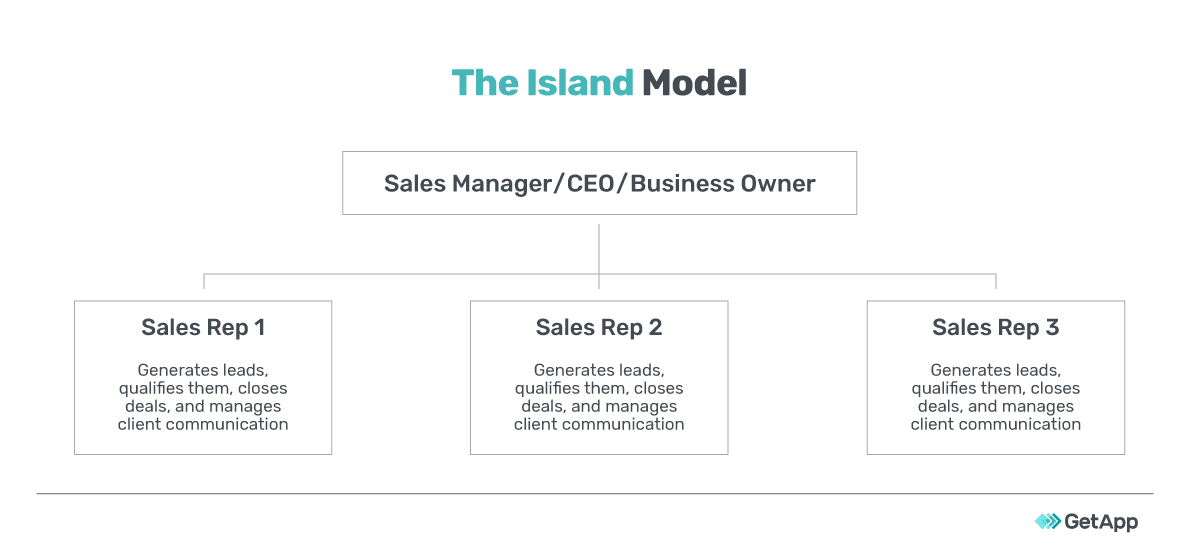 The assembly line asks reps to specialize in one part of the sales process and work with a variety of leads during only that stage.
The assembly line asks reps to specialize in one part of the sales process and work with a variety of leads during only that stage.
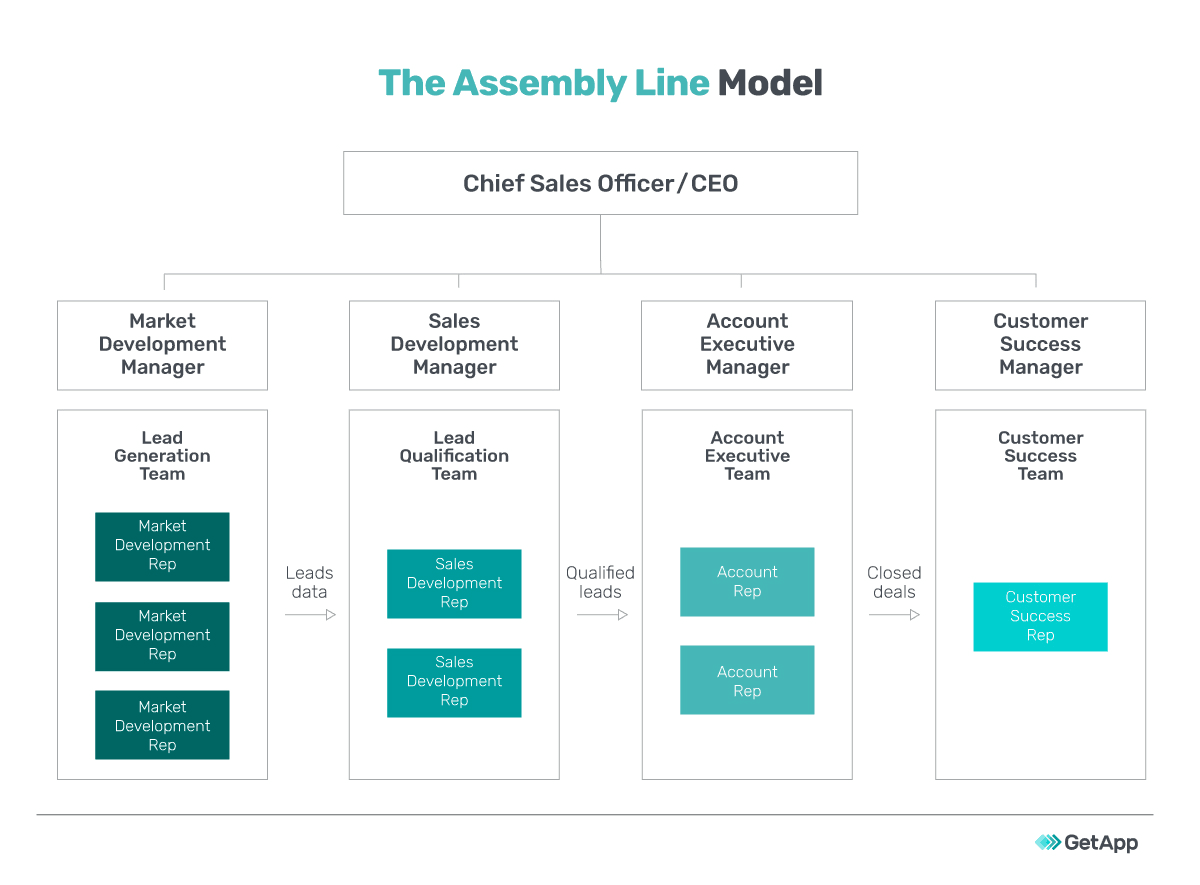 The pod model groups your salesforce into smaller teams, with each team broken down by role.
The pod model groups your salesforce into smaller teams, with each team broken down by role.
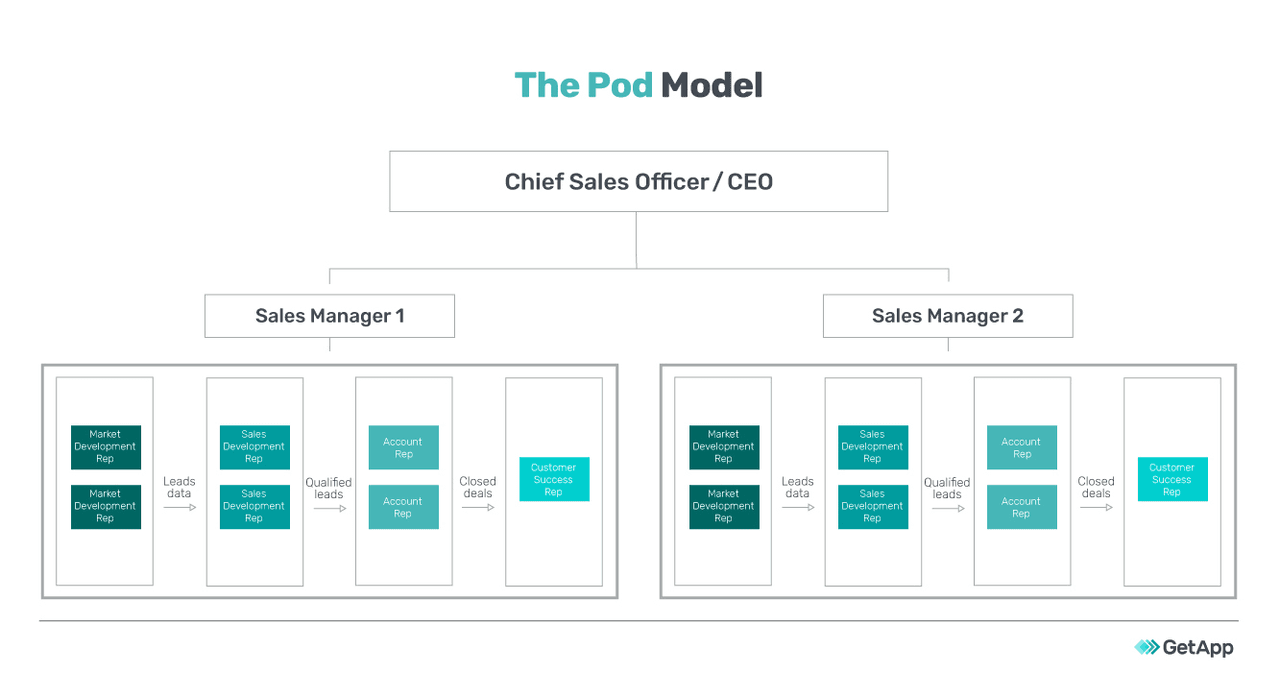 Each model has pros and cons, so be sure to consider which would work best for your team. Check out our post on sales team structures to learn more.
Each model has pros and cons, so be sure to consider which would work best for your team. Check out our post on sales team structures to learn more.
Hire in Pairs
It’s best practice to hire new sales team members in pairs or groups. This will help sales managers have a built-in anchor or point of reference by which to measure progress and success.
The intention here isn’t to pit your new hires against one another, so avoid making this a competition. You simply want to be able to notice strengths and weaknesses among the team from a holistic point of view.
Use a Hiring Matrix
Mark Roberge, Hubspot’s first-ever salesperson and the man responsible for creating the process that has made the team what it is today, suggests using a hiring matrix for all new employees.
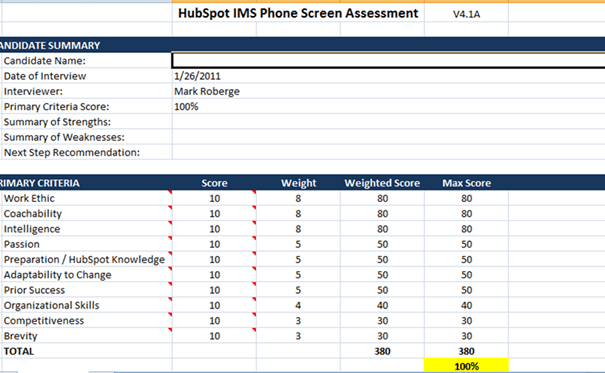
Notice that the top attributes Roberge sought in this particular matrix are not directly related to sales. Instead, Roberge suggests that hiring managers hire candidates who demonstrate strong work ethic and coachability.
Develop a Great Onboarding Process
In order for your sales reps to ramp up quickly, you need a stellar onboarding process.
Be sure to design an onboarding program that is comprehensive and thorough. You’ll waste more time having to fill in knowledge and training gaps later down the line than if you take the extra time up front to ensure your employees are well-equipped to get the ball rolling.
Fire as Quickly as You Hire
It can be hard to let go of a new hire that you hoped would work out. Ample time, financial, and energy resources go into hiring new team members.
The truth is that it’s far more expensive to retain a bad-fit hire than it is to fire them as quickly as you’re aware something isn’t working. This is one instance where it’s okay to go with your gut; if you suspect a new hire isn’t fitting in, let them go sooner than later.
Start Building Your Tech Stack Alongside Your Team
Any growing sales team will need a suite of tech tools to support their sales activities. Be mindful to build your tech stack alongside your team.
Look for tech tools that will help your sellers automate tasks that don’t directly help reps close deals. Check out our free ebook here for more detailed information about how and when to build your tech stack.
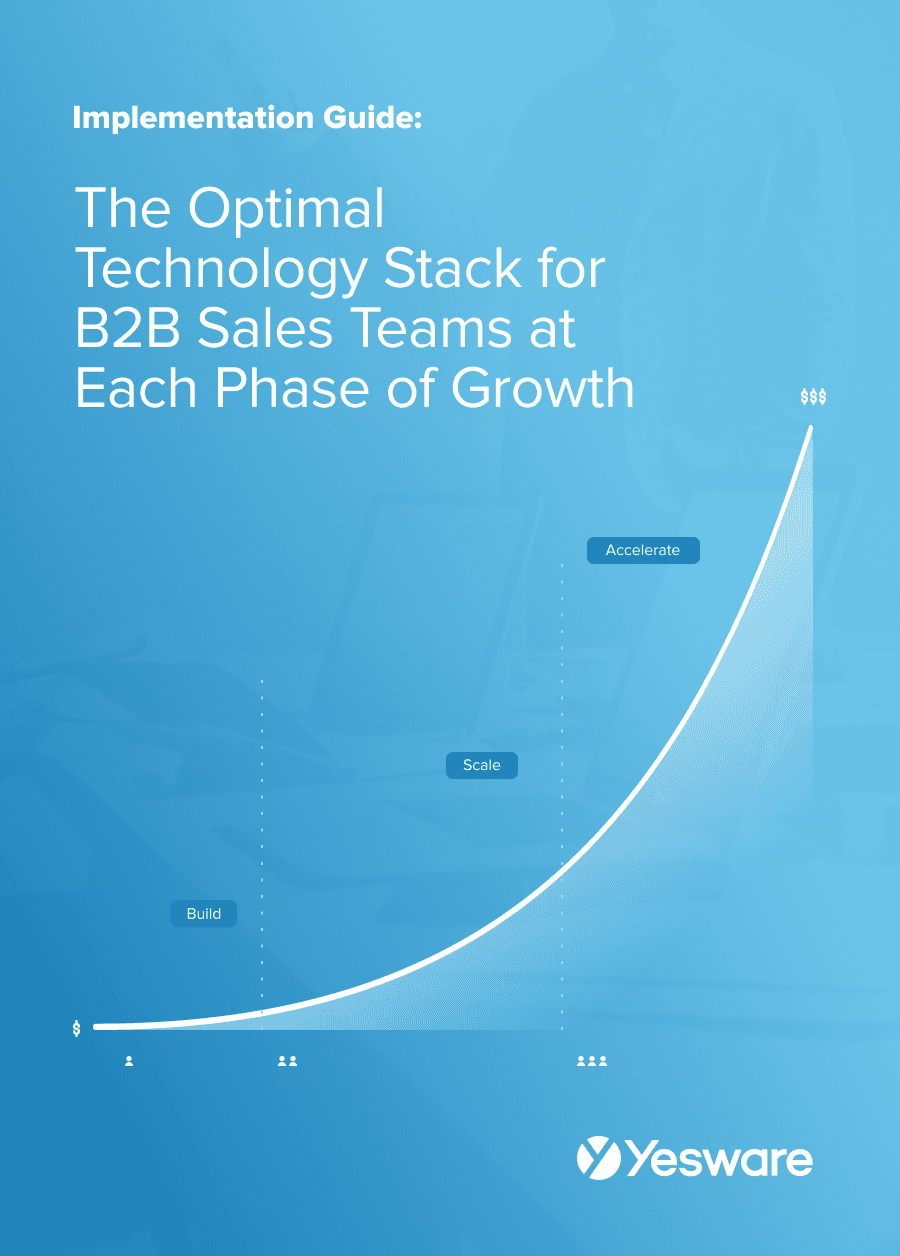 The Optimal Technology Stack for B2B Sales TeamsUsing data from the most successful business-scaling models, we designed a blueprint for the exact technology your business needs at each phase of growth.
The Optimal Technology Stack for B2B Sales TeamsUsing data from the most successful business-scaling models, we designed a blueprint for the exact technology your business needs at each phase of growth.
Build a Framework for Coaching
As soon as possible, sales managers should design a coaching program and schedule. Be mindful here — coaching is not the same thing as training.
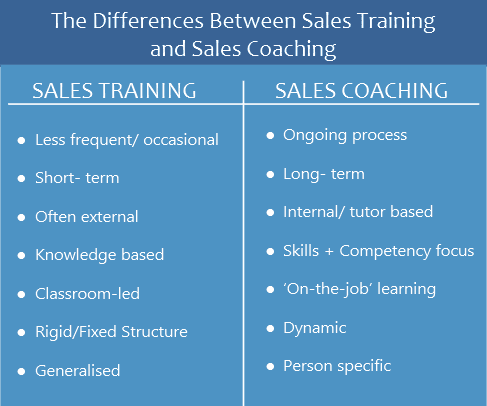
Sales coaching takes a bit more effort and planning than training does, but it’s well worth it: most high-performing sales teams have managers that spend at least 20% of their time coaching.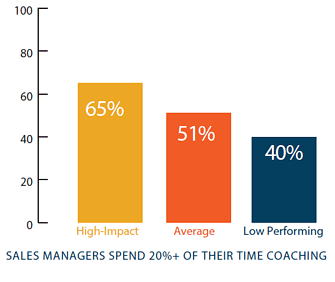 Coaching requires regular one-on-one meetings with your sales reps, so be sure to carve out enough time to meet this need for everyone on your team.
Coaching requires regular one-on-one meetings with your sales reps, so be sure to carve out enough time to meet this need for everyone on your team.
Techniques for Becoming a Great Salesperson
The best salespeople in any field are the ones who always strive to become better. The following tips will help you transform from an average salesperson to an outstanding one, no matter what field or experience level you currently command.
Improve Relationship-Building Skills
Remember that the true definition of sales lies in a seller’s ability to build trusting, authentic relationships with buyers.
One of the best things you can do as a sales professional, no matter how much experience or success you have behind you, is to improve your relationship-building skills. You can do this by building your emotional intelligence (EQ).
There are a number of ways to improve your EQ, but one easy way to start is to pay attention to your active listening skills.
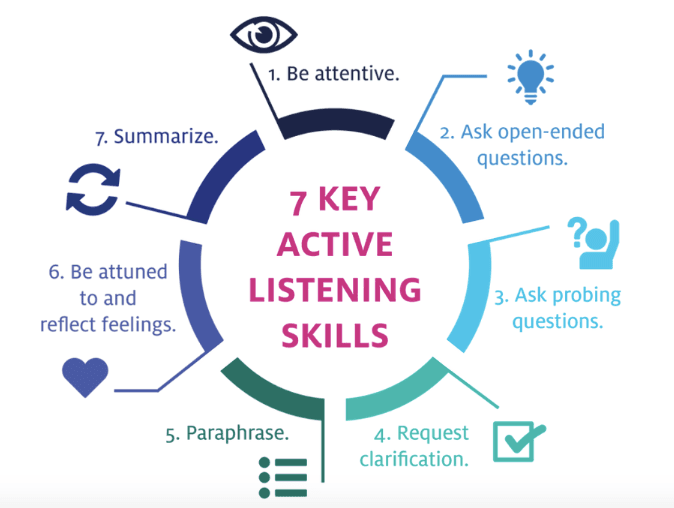
Active listening can go a long way in making your prospective customers feel heard and understood.
Ask Better Questions
The difference between a lukewarm prospect and a hot lead can be as simple as the way you ask them questions.
Try practicing open-ended questions to get your prospects to open up and engage.
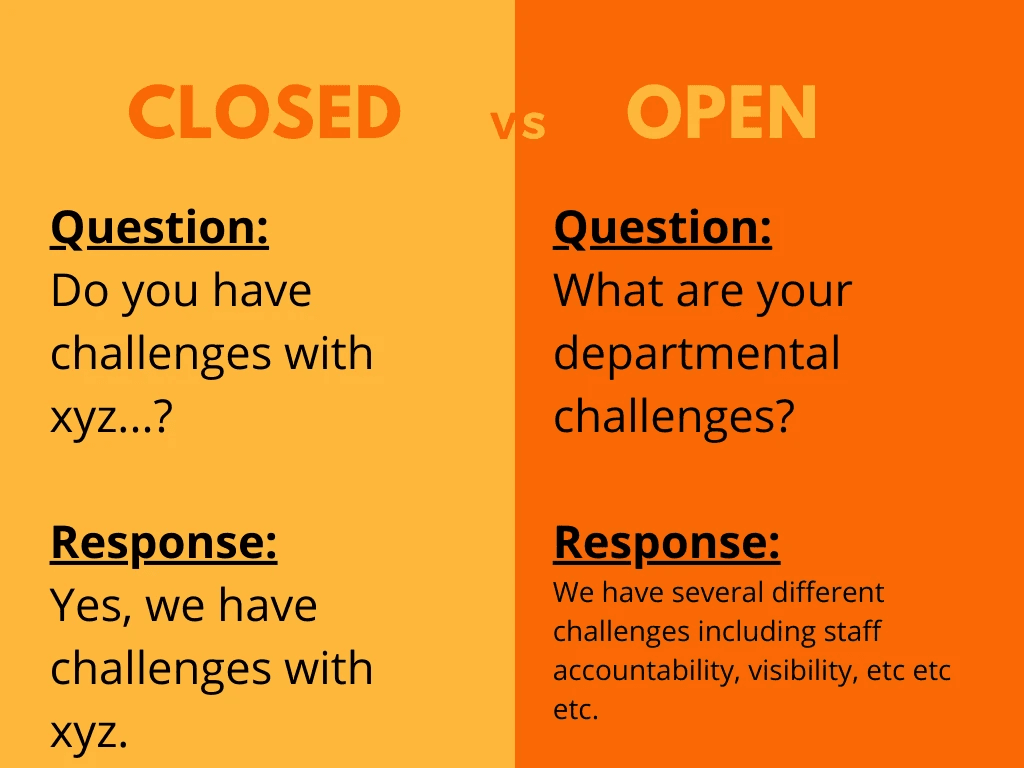
Open-ended sales questions can accelerate the sales process by helping sellers learn more about the pain points and frustrations that your leads are hoping to solve.
Adopt a Growth Mindset
One of the best ways to become great at something — certainly sales, but anything else in your life that could stand for improvement, too — is to adopt a growth mindset.
A growth mindset enables people to use mistakes and failures as opportunities to learn.
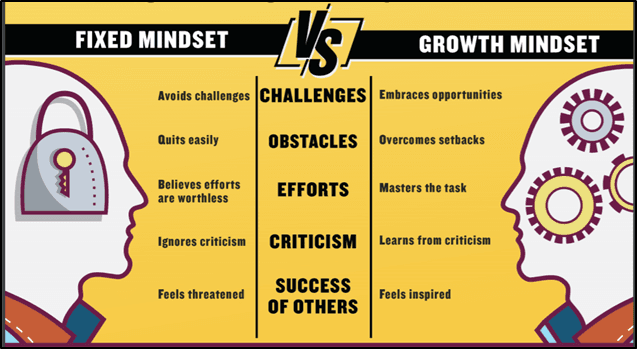
The ability to operate from a growth mindset is a learned skill, and can take some practice. Monitor your own thoughts and how you react to challenges and setbacks. These are perfect opportunities to shift your mindset out of a fixed stance and into one of growth.
How to Meet Your Sales Goals
Mindset work and other soft skills are certainly important, but metrics matter, too. It’s important to make sure that you meet your sales goals along the way.
Here are three key ways to keep your eyes on the prize as you work to exceed your sales goals.
SMART Goals
Many people struggle with goal-setting. That’s because they often don’t realize that the process of setting goals is as important as the goals themselves.
Practice setting effective goals using a SMART framework.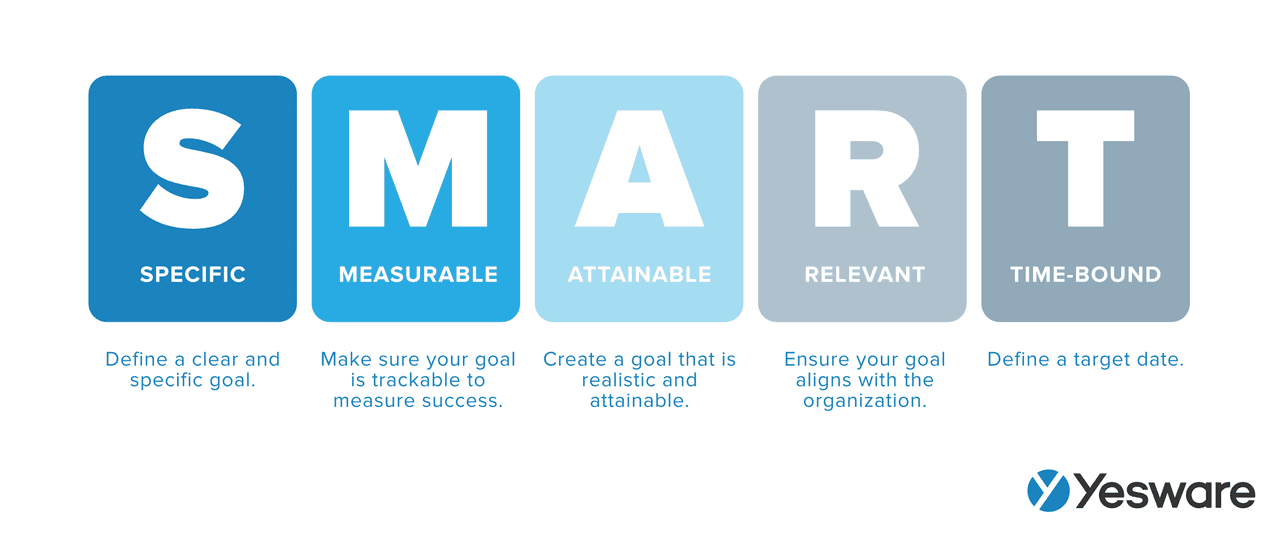
The SMART goal framework will help break your goals down into small, measurable subgoals, making them more achievable and easier to troubleshoot if something goes awry.
Practice Better Time Management
Salespeople spend only about one-third of their day on revenue-generating sales activities.
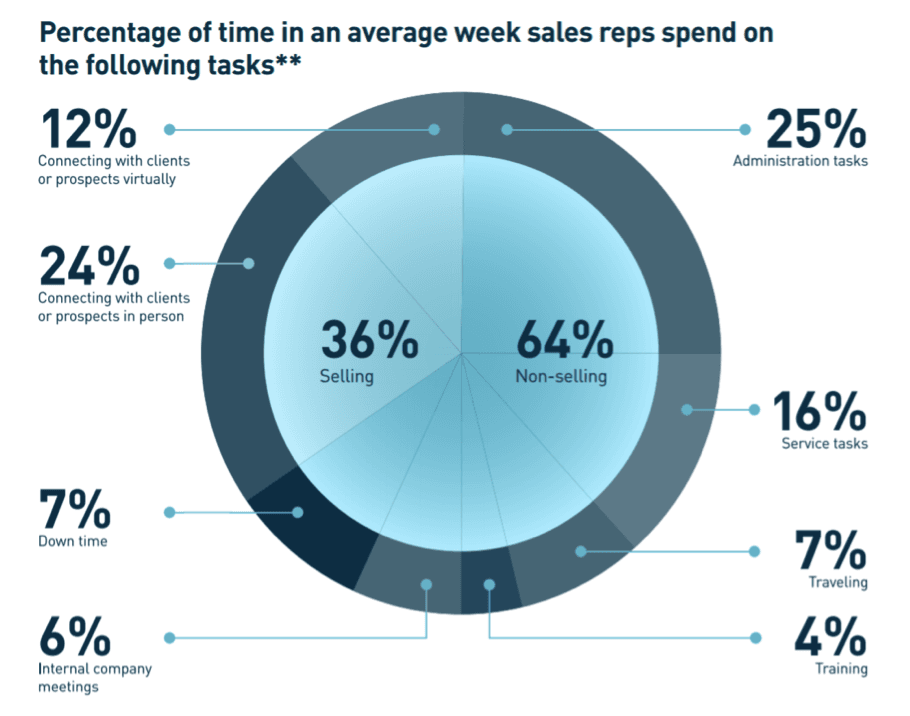
Unfortunately, it’s unlikely that these expectations placed on salespeople will let up any time soon. That’s why it’s so important that salespeople stay on top of their time management. Automate anything and everything you can, and create self-managed systems for everything else.
Focus On Your Value Offering
In order for salespeople to meet their goals, sales and marketing need to align to develop a strong value offering.
Remember, buyers don’t buy products — they buy solutions to their product. The better you can position your offering as the best solution to their problem, the more likely you are to close deals.
Try Yesware for free today to learn how we can help you start selling.
Get sales tips and strategies delivered straight to your inbox.
Yesware will help you generate more sales right from your inbox. Try our Outlook add-on or Gmail Chrome extension for free, forever!
Related Articles
Melissa Williams
Melissa Williams
Casey O'Connor
Sales, deal management, and communication tips for your inbox

